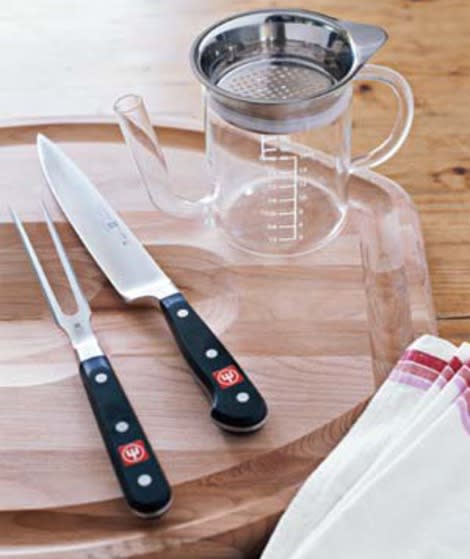How to Fix 10 Common Thanksgiving Problems
A guide to get you over some of the holiday dinner's most common hurdles.
Problem: You Don't Know How Big a Turkey to Buy
You want to be sure you have enough turkey but have no clue how many pounds you need for the number of guests you're going to have.
Solution
If you need only enough turkey to make it through Thanksgiving dinner: Buy ¾ to 1 pound per person.
If you want enough leftovers for the long weekend: Calculate 1 pounds (or slightly more) per person. Get leftover turkey recipes and turkey sandwich ideas.
If you need a large turkey: Consider buying two 10- to 12-pound birds and roasting them side by side. Small turkeys cook (and defrost) much more quickly than supersize ones, and they tend to stay moister. Print out this simple turkey recipe to get started.
See More: Choose the Right Thanksgiving Turkey
Problem: The Turkey Is Still Frozen
It's 10 a.m. on Thanksgiving Day. Dinner is at 2 p.m. And the turkey, which has been thawing for days in the refrigerator, still feels frozen solid.
Solution
Give the bird a cold bath. Water is a much better conductor of heat than air in the refrigerator, so this method works faster, says Robert L. Wolke, professor emeritus of chemistry at the University of Pittsburgh and the author of What Einstein Told His Cook 2 ($26, amazon.com). Fill a large bucket or the kitchen sink with cool water and plunge the bird in, in the original wrapper, breast-side down.
If the turkey has been defrosting in the refrigerator for several days, a mere half hour may do the trick. If you need to defrost a fully frozen turkey on the double, allow half an hour per pound. The U.S. Department of Agriculture advises changing the water every 30 minutes or so. (Birds labeled "fresh" can be chilled to 26° F, which explains why such turkeys can unexpectedly turn out to be partially frozen. The USDA suggests that you buy a fresh turkey no more than 2 days before you roast it.) No matter how dire the situation, don't thaw a turkey at room temperature. If it's early in the week and there's no rush, thaw the turkey in the refrigerator. Keep it in the original packaging, and place it on a rimmed container to catch any juices, allowing approximately 5 hours per pound.
See More: How to Roast Thanksgiving Turkey
Problem: To Baste or Not to Baste?
You want to put the bird in the oven and forget about it. Your husband wants to baste it at every commercial break.
Solution
It depends on your priorities. "Basting is purely a skin treatment," says Wolke. Its only purpose is to facilitate browning and crisping. He adds that rubbing the turkey generously with oil or butter before you put it in the oven will do the job almost as well. (But be sure to pat the bird completely dry first; if the skin is wet, the fat won't adhere.)
Not only is frequent basting a hassle but it can also wreak havoc with your cooking time. "If you do it every 20 minutes or so," Wolke says, "you're losing a lot of heat from the oven by opening the door frequently." If you or that loved one in your kitchen insists on basting, cookbook author and chef Sara Moulton advises that you prevent excess heat from escaping by taking the entire pan out of the oven and closing the door.
See More: 10 Recipe Ideas for Stuffing
Problem: You Can't Tell if the Turkey Is Done
The drumsticks wiggle. The juices run clear. But you're still not sure if the turkey is ready.
Solution
Take its temperature.
"You need a thermometer for dependable accuracy," says Moulton. Insert one―oven-safe or instant-read―in several places, being careful not to allow the tip to touch bone. According to the USDA, turkey is cooked through when the internal temperature of a thigh reaches 180° F. (When gauging doneness, keep in mind that the meat continues to cook―and subsequently rises a few degrees―even after it comes out of the oven.) Learn how to take a turkey's temperature by watching this video.
See More: 10 Mashed Potato Recipe Ideas
Problem: The Turkey Needs to Be Transferred
You need to deftly shift a hot, dripping, unwieldy turkey from roasting pan to carving board without…oops!
Solution
Ask yourself, Modern gadgetry or old-fashioned ingenuity? There are a number of products designed to minimize the awkwardness, from pricey (and iffy) turkey transport forks to extremely reliable roasting racks.
For a homespun alternative, scrunch up paper towels or aluminum foil in each hand as a buffer between hot bird and fingers, suggests Pam Anderson, author of Perfect Recipes for Having People Over ($35, amazon.com). Some home cooks prefer heavy-duty cleaning gloves. Others use oven mitts that are ready for the rag pile. Engineering types fashion a turkey hammock out of kitchen string and place it in the pan under the raw bird. Or you can simply reach for a couple of sturdy wooden spoons, indelicately insert one into each end of the bird, and let your steady hands guide the way. Learn how to transfer a turkey by watching this video.
See More: How to Fix 10 Common Thanksgiving Problems
Don't Miss:
24 Make-Ahead Thanksgiving Recipes
4 Foolproof Pie Recipes
How to Make the Most of Thanksgiving Leftovers

